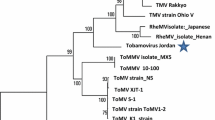Abstract
A tobamovirus was isolated from leaves of a Scopolia japonica plant showing mild yellowing. Back-inoculation of healthy Scopolia japonica with the isolated virus induced mild mottle on upper leaves. Phylogenetic analysis based on coat protein and replicase protein sequences revealed that the newly isolated tobamovirus was most closely related to yellow tailflower mild mottle virus (YTMMV). The newly isolated tobamovirus shared the highest nucleotide sequence identity (71%) with YTMMV, which is lower than the cutoff (90%) set for species demarcation in the genus Tobamovirus. Thus, our result suggested that scopolia mild mottle virus (SMMoV) is a new tobamovirus that infects Scopolia japonica plants in Japan.


Similar content being viewed by others
References
Daniel P, Cheng K, Katalin AH (2005) Pokeweed antiviral protein inhibits brome mosaic virus replication in plant cells. J Biol Chem 280:20069–20075
Dayhoff MO (1978) Survey of new data and computer methods of analysis. In: Dayhoff MO (ed) Atlas of protein sequence and structure, vol 5. National Biomedical Research Foundation, Washington, DC, p 29
Gasteiger E, Hoogland C, Gattiker A, Duvaud S, Wilkins MR, Appel RD, Bairoch A (2005) Protein identification and analysis tools on the ExPASy server. In: Walker JM (ed) The proteomics protocols handbook. Humana Press, New Jersey, pp 571–607
Harashima H (2017) Scopolia japonica. Shoyakutan the 3rd edition: word book of botanical and Latin names with etymological memory aids (Svs) Ito M, Kitamura T. Maruzen-Yushodo (Tokyo), pp 266–267
Hatakeyama Y, Kumagai T, Kanno E, Li Y, Maehira Y, Yoneda K (1993) Studies on the cultivation and breeding of wild medical plants (II) on the cultivation of Scopolia japonica in Hokkaido. Syoyakugaku Zassi 47(1):22–26
Hisata Y, Kawamura T, Okuda K, Noro Y, Tanaka T, Sakai E, Hatakeyama Y (1989) Studies of scopoliae rhizoma (1) variation of alkaloid contents of cultivated Scopolia japonica. Syoyakugaku Zassi 43(2):159–162
Katsuyama T (2017) Solanaceae. In: Ohashi H, Kadota Y, Murata J, Yonekura K (eds) Wild flowers of Japan, vol 5. Heibonsha, Tokyo, pp 33–46
Kumar S, Stecher G, Li M, Knyaz C, Tamura K (2018) MEGA X: molecular evolutionary genetics analysis across computing platforms. Mol Biol Evol 35:1547–1549
Larkin MA, Blackshields G, Brown NP, Chenna R, McGettigan PA, McWilliam H, Valentin F, Wallace IM, Wilm A, Lopez R, Thompson JD, Gibson TJ, Higgins DG (2007) Clustal W and Clustal X version 2.0. Bioinfomatics 23:2947–2948
Mimaki Y (2020) Solanaceae. In: Takeya K, Kiuchi F, Komatsu K (eds) Partner pharmacognosy. Nankodo, Tokyo, pp 289–294
Pelikanova J, Petrzik K, Honetslegrova J (1992) The discovery of belladonna mottle virus in Czechoslovakia and its comparison with a Hungarian isolate of this virus. J. Phytopathol 134:10–16
Salamon P, Salánki K (2001) Virus diseases and viruses of cultivated and wild-growing Solaneaous plants in Hungary. 4. Spontaneous occurrence of cucumber mosaic virus (CMV) on Scopolia carniolica Jacq. Növényvédelem vol 37, pp 123–127. ISSN: 0133-0829
Stephen JW, Hua L, Michael GK (2014) Yellow tail flower mild mottle virus: a new tobamovirus described from Anthocercis littorea (Solanaceae) in Western Australia. Arch Virol 159:791–795
WFO (2021) Scopolia. World Flora Online. Published on the Internet. http://www.worldfloraonline.org. Accessed on 07 Jun 2021
Wenhui G, Xiang L, Bin L, He Y, Juntao F (2021) Anti-TMV activity and mode of action of three alkaloids isolated from Chelidonium majus. Pest Manage Sci 77:510–517
Wheeler DL, Church DM, Federhen S, Lash AE, Madden TL, Pontius JU, Schuler GD, Schriml LM, Sequeira E, Tatusova TA, Wagner L (2003) Database resources of the National Center for Biotechnology. Nucleic Acids Res 31:28–33
Acknowledgements
This research was supported by a Genebank project, National Agriculture and Food Research Organization (NARO) and AMED under grant number 21ak0101105h0002.
Author information
Authors and Affiliations
Corresponding author
Ethics declarations
Conflict of interest
The authors declare that they have no conflict of interest. This article does not contain any studies with human participants or animals performed by any of the authors.
Additional information
Handling Editor: Elvira Fiallo-Olivé.
Publisher's Note
Springer Nature remains neutral with regard to jurisdictional claims in published maps and institutional affiliations.
Supplementary Information
Below is the link to the electronic supplementary material.
Rights and permissions
About this article
Cite this article
Uehara-Ichiki, T., Uke, A., Hanada, K. et al. Scopolia mild mottle virus: a new tobamovirus isolated from a Scopolia japonica plant in Japan. Arch Virol 167, 947–951 (2022). https://doi.org/10.1007/s00705-022-05371-4
Received:
Accepted:
Published:
Issue Date:
DOI: https://doi.org/10.1007/s00705-022-05371-4




